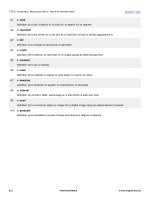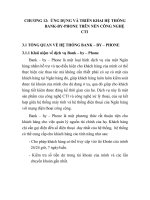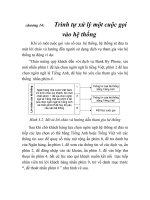Gilbertus Anglicus, by Henry Ebenezer Handerson docx
Bạn đang xem bản rút gọn của tài liệu. Xem và tải ngay bản đầy đủ của tài liệu tại đây (751.48 KB, 305 trang )
The Project
Gutenberg eBook,
Gilbertus
Anglicus, by
Henry Ebenezer
Handerson
This eBook is for the use of anyone
anywhere at no cost and with
almost no restrictions whatsoever. You
may copy it, give it away or
re-use it under the terms of the Project
Gutenberg License included
with this eBook or online at
www.gutenberg.net
Title: Gilbertus Anglicus
Medicine of the Thirteenth Century
Author: Henry Ebenezer Handerson
Release Date: June 30, 2005 [eBook
#16155]
Language: English
Character set encoding: ISO-8859-1
***START OF THE PROJECT
GUTENBERG EBOOK GILBERTUS
ANGLICUS***
E-text prepared by Suzanne
Lybarger, William Flis,
and the Project Gutenberg Online
Distributed Proofreading Team
( />from page images generously made
available by
Internet Archive and Canadian
Libraries
( />
Note:
Images of the original pages are available through the
Internet Archive and Canadian Libraries. See
/>
GILBERTUS
ANGLICUS
Medicine of the
Thirteenth Century
by
HENRY E. HANDERSON,
A.M., M.D.
With a Biography of the
Author
Published Posthumously
FOR PRIVATE DISTRIBUTION
by
The Cleveland Medical
Library Association
CLEVELAND, OHIO
1918
Contents
Page
Frontispiece 5
Explanatory Foreword 7
Biography 9-14
Resolutions of the Cleveland Medical
Library Ass'n 15
Gilbertus Anglicus—A Study of
Medicine in the Thirteenth
Century 17-78
HENRY E. HANDERSON
Explanatory Foreword
In the summer of 1916 the librarian of
the Cleveland Medical Library received
a manuscript from Dr. Henry E.
Handerson with the request that it be
filed for reference in the archives of the
library. The librarian at once recognized
the value of the paper and referred it to
the editorial board of the Cleveland
Medical Journal, who sought the
privilege of publishing it. Dr.
Handerson's consent was secured and
the article was set in type. However,
when the time came for its publication
the author was reluctant to have it
appear since he was unable then to read
the proof, and because he felt that the
material present might not be suitable for
publication in a clinical journal. To
those who knew him, this painstaking
attention to detail and desire for
accuracy presents itself as a familiar
characteristic. Though actual publication
was postponed, the type forms were
held, and when the Cleveland Medical
Journal suspended publication, its
editorial board informed the Council of
the Cleveland Medical Library
Association of the valuable material
which it had been unable to give to the
medical world. In the meantime Dr.
Handerson's death had occurred, but the
Council obtained the generous consent of
the author's family to make this
posthumous publication. It is hoped that
those who read will bear this fact in
mind and will be lenient in the
consideration of typographical errors, of
which the author was so fearful.
The Cleveland Medical Library
Association feels that it is fortunate in
being enabled to present to its members
and to others of the profession this work
of Dr. Handerson's and to create from
his own labors a memorial to him who
was once its president.
SAMUEL W. KELLEY.
CLYDE L. CUMMER.
Committee on Publication.
Biography
HENRY EBENEZER
HANDERSON
Owing to Dr. Handerson's modesty, even
we who were for years associated with
him in medical college, in organization,
and professional work, knew but little of
him. He would much rather discuss some
fact or theory of medical science or
some ancient worthy of the profession
than his own life. Seeing this tall
venerable gentleman, sedate in manner
and philosophical in mind, presiding
over the Cuyahoga County Medical
Society or the Cleveland Medical
Library Association, few of the members
ever pictured him as a fiery, youthful
Confederate officer, leading a charge at
a run up-hill over fallen logs and brush,
sounding the "Rebel yell," leaping a
hedge and alighting in a ten-foot ditch
among Federal troopers who
surrendered to him and his comrades.
Yet this is history. We could perhaps
more easily have recognized him even
though in a military prison-pen, on
finding him dispelling the tedium by
teaching his fellow prisoners Latin and
Greek, or perusing a precious volume of
Herodotus.
Henry Ebenezer Handerson was born on
March 21, 1837, here in Cuyahoga
county, in the township of Orange, near
the point now known as "Handerson's
Cross-Roads," on the Chagrin river. His
mother's maiden name was Catharine
Potts. His father was Thomas
Handerson, son of Ira Handerson. The
family immigrated to Ohio from
Columbia county, New York, in 1834.
Thos. Handerson died as the result of an
accident in 1839, leaving the widow
with five children, the eldest thirteen
years of age, to support. Henry and a
sister were adopted by an uncle, Lewis
Handerson, a druggist, of Cleveland. In
spite of a sickly childhood the boy went
to school a part of the time and at the age
of fourteen was sent to a boarding
school, Sanger Hall, at New-Hartford,
Oneida county, New York. Henry's poor
health compelled him to withdraw from
school. No one at that time would have
predicted that the delicate youth would
live to be the sage of four score years
and one. With his foster father and
family he moved to Beersheba Springs,
Grundy county, Tennessee.
In 1854, in good health, the boy returned
to Cleveland, prepared for college, and
entered Hobart College, Geneva, New
York, where he graduated as A.B. in
1858. Returning to Tennessee, he
occupied himself for about a year with
surveying land and in other work and
then became private tutor in the family of
Mr. Washington Compton on a cotton
plantation near Alexandria, Louisiana.
There he remained a year or more, then
in the autumn of 1860 matriculated in the
Medical Department of the University of
Louisiana (now Tulane University),
where he studied through the winter, and
also heard much of the political oratory
of that exciting period.
The bombardment of Fort Sumter, April
12, 1861, followed by the call of
President Lincoln for 75,000 troops to
suppress the rebellion, found young
Handerson again employed as tutor, this
time in the family of General G. Mason
Graham, a veteran of the Mexican war.
With his friends and acquaintances,
Handerson joined a company of
"homeguards" consisting mostly of
planters and their sons, formed for the
purpose of maintaining "order among the
negroes and other suspicious characters
of the vicinity."
Many years afterward Dr. Handerson
wrote, in a narrative for his family,
concerning this period of his life:
"Without any disposition to violent
partisanship, I had favored the party of
which the standard-bearers were Bell
and Everett and the battle cry 'The
Constitution and the Union,' and I had
grieved sincerely over the defeat by the
Radicals of the North, aided by the 'fire-
eaters' of the South."
And again: "Born and educated in the
North, I did not share in any degree the
fears of the Southerners over the election
to the Presidency of Mr. Lincoln. I could
not but think the action of the seceding
States unwise and dangerous to their
future prosperity. On the other hand, this
action had already been taken, and
without any prospect of its revocation.
Indeed, in the present frame of mind of
the North, any steps toward recession
seemed likely to precipitate the very
evils which the secession of the states
had been designed to anticipate. I
believed slavery a disadvantage to the
South, but no sin, and, in any event, an
institution for which the Southerners of
the present day were not responsible. An
inheritance from their fore-fathers,
properly administered, it was by no
means an unmitigated evil, and it was
one, moreover, in which the North but a
few years before had shared. All my
interests, present and future, apparently
lay in the South and with Southerners,
and if the seceding States, in one of
which I resided, chose deliberately to
try the experiment of self-government, I
felt quite willing to give them such aid
as lay in my feeble power. When I add
to this that I was 24 years of age, and
naturally affected largely by the ideas,
the enthusiasm and the excitement of my
surroundings, it is easy to understand to
what conclusions I was led."
So on June 17, 1861, he volunteered in
the Stafford Guards under Capt.
(afterward Brigadier General) L.A.
Stafford. The Guards became company
B of the 9th Regiment of Louisiana
Volunteers, Confederate States of
America, Colonel (later Brigadier
General) "Dick" Taylor (son of "Old
Zach," the President of the U.S.), in
command. During the year that followed
until the close of the war, Handerson
experienced the adventures and trials of
a soldier's life. He knew picket,
scouting, and skirmishing duty, the
bivouac, the attack and defense in battle
formation, the charge, the retreat, hunger
and thirst, the wearisome march in heat
and dust, in cold, in rain, through
swamps and stony wildernesses. He was
shot through the hat and clothing and
once through the muscles of the shoulder
and neck within half inch of the carotid
artery, lay in a hospital, and had
secondary hemorrhage. At another time
he survived weeks of typhoid fever.
He was successively private soldier and
accountant for his company, quarter-
master, 2nd Lieutenant of the line,
Captain of the line, and finally Adjutant
General of the 2nd Louisiana Brigade,
A. N. Va., under Lee and Jackson, with
rank of Major. On May 4, 1864,
Adjutant General Handerson was taken
prisoner, and from May 17th until
August 20th he was imprisoned at Fort
Delaware in the Delaware river. He was
then confined in a stockade enclosure on
the beach between Forts Wagner and
Gregg on Morris Island, until about the
end of October, when he was transferred
to Fort Pulaski at the mouth of the
Savannah river, and in March, 1865,
back to Fort Delaware. In April, after
Lee's surrender, many of the prisoners
were liberated on taking the oath of
allegiance to the Federal Government.
But Handerson did not consider his
allegiance to the Southern Confederacy
ended until after the capture of President
Davis, and it was not until June 17,
1865, that he signed the oath of
allegiance and was liberated in
Philadelphia.
Since that time, with that spirit of
tolerance and openness to truth which
characterized the man, he has said, "in
the triumph of the Union, the war ended
as it should have ended."
Mr. Handerson then resumed his medical
studies, this time in the College of
Physicians and Surgeons of New York,
M e d i c a l Department of Columbia
University, taking the degree of M.D. in
1867. Hobart College conferred the
A.M. in 1868. On October 16, 1872, he
married Juliet Alice Root, who died
leaving him a daughter.
February 25, 1878, Dr. Handerson read
before the Medical Society of the County
of New York an article entitled, "The
School of Salernum, an Historical
Sketch of Mediæval Medicine." This
essay attracted wide attention to his
scholarly attainments and love of
laborious research. For example,
Professor Edward Schaer of the chair of
Pharmacology and Pharmaceutical
Chemistry, of Neumünster-Zürich,
pronounces this pamphlet "a valuable
gift a remarkable addition to other
historical materials in connection with
the history of pharmacy and of
pharmaceutical drugs"; that he found in it
"a great deal of information which will
be sought for in vain in many even









